780th Expeditionary Airlift Squadron
| 780th Expeditionary Airlift Squadron | |
|---|---|
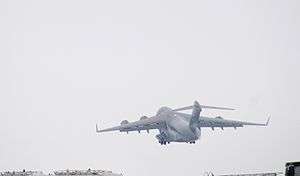 A C-17 Globemaster III of the 780th taking off from Mihail Kogalniceanu Air Base | |
| Active | 1943–1945; 1953–1958; 2014–present |
| Country |
|
| Branch |
|
| Role | Airlift |
| Part of | Air Mobility Command |
| Engagements | Mediterranean Theater of Operations[1] |
| Decorations |
Distinguished Unit Citation Air Force Outstanding Unit Award[1] |
| Insignia | |
| 780th Expeditionary Airlift Squadron emblem |
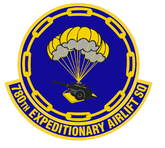 |
| 780th Troop Carrier Squadron emblem (Approved 17 June 1955)[2] |
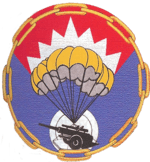 |
| 780th Bombardment Squadron emblem[3] |
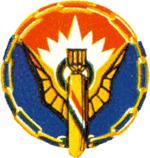 |
The 780th Expeditionary Airlift Squadron is a provisional active United States Air Force unit. It is assigned to Air Mobility Command to activate or inactivate as needed for contingency operations.
The squadron was first activated in 1943 as the 780th Bombardment Squadron. It served in combat in the Mediterranean Theater of Operations as a Consolidated B-24 Liberator unit, earning two Distinguished Unit Citations for its actions. After V-E Day, the squadron served in Air Transport Command, ferrying men from the combat theater back to the United States.
The squadron was activated again in 1953, when it replaced a reserve squadron that had been mobilized for the Korean War. It moved to France, where it provided theater airlift until inactivating in 1958. The squadron was converted to provisional status in 2002 and was activated in 2014.
History
World War II

The squadron was first activated at Alamogordo Army Air Field, New Mexico as the 780th Bombardment Squadron, one of the four original Consolidated B-24 Liberator heavy bomber squadrons of the 465th Bombardment Group. After training under Second Air Force, the squadron deployed to the Mediterranean Theater of Operations in February 1944.[1][4]
The squadron arrived in the Mediterranean Theater of Operations, where it was stationed at Pantanella Airfield, Italy in March 1944. The air echelon halted in Tunisia for additional training before completing its move to Italy, where it became part of Fifteenth Air Force. It flew strategic bombardment combat missions over France, Germany, Italy, Austria and the Balkans, attacking targets such as marshalling yards, docks, aircraft factories and oil production facilities. On 8 July 1944 the squadron attacked an oil refinery and marshalling yards near Vienna, Austria despite heavy flak and fighter opposition, earning the unit a Distinguished Unit Citation. It was awarded a second citation for an attack on 3 August 1944 against a steel plant in Friedrichshafen, Germany.[4]
The squadron was occasionally diverted from the strategic campaign. It attacked troop concentrations in May 1944 to assist partisan forces in Yugoslavia and performed interdiction missions to support the advance on Rome. Prior to Operation Dragoon, the invasion of southern France, it attacked bridges, railroads and gun emplacements near the landing area. It supported Red Army and Romanian Army forces advancing in the Balkans in October 1944 and Allied forces in Northern Italy in April 1945.[4]
The squadron moved to Waller Field, Trinidad and became part of Air Transport Command in June 1945. It used its Liberators as transports, flying personnel from Trinidad to Florida. The unit was inactivated in Trinidad during July 1945. The squadron was redesignated as very heavy bomber squadron in 1945, but remained inactive.[1][4]
Airlift operations
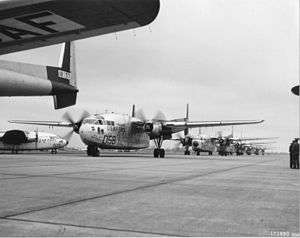
In February 1953, Tactical Air Command activated the 465th Troop Carrier Group at Donaldson Air Force Base, South Carolina to replace the 433d Troop Carrier Group, a reserve unit that had been mobilized for the Korean War. The squadron was redesignated the 780th Troop Carrier Squadron and assumed the personnel, mission and aircraft of the 309th Troop Carrier Squadron, which was simultaneously inactivated.[1][4][5] The 443d Group was in the process of converting to the Fairchild C-119 Flying Boxcar from the Curtiss C-46 Commando it was flying when mobilized at the time it was replaced by the 465th.[6]
The squadron's intended base at Évreux-Fauville Air Base, France was still under construction, so in December, the 465th Group and the squadron moved to Toul-Rosières Air Base, France. In November the squadron's ground echelon sailed on on the USS General Alexander M. Patch, while the air echelon departed Donaldson with their C-119s at the beginning of December. Although construction at Toul had progressed, it could only accommodate a single flying squadron, and the group's other squadrons moved to bases in Germany.[6] By April 1954, construction at Toul was advanced enough that its parent 465th Troop Carrier Wing and the other flying squadrons could join it.[note 2] The squadron participated in airlift operations, tests and exercises in Europe.[7] Although the squadron mission was troop carrier, there were few American airborne troops in Europe, and it focused on theater airlift flights, particularly supporting fighter units deploying to Wheelus Air Base for training at the ranges there.[6]
In March 1957, the 465th Wing reorganized under the dual deputy model. The 465th Group was inactivated and the 780th was reassigned directly to the 465th Wing. Four months later, the 465th Wing inactivated and transferred its operational squadrons to the 317th Troop Carrier Wing, which had moved to Évreux-Fauville Air Base from its former station at Neubiberg Air Base, Germany.[7][8] The squadron continued airlift operations in France until inactivating in March 1958.[1]
Expeditionary operations
The 780th was converted to provisional status in June 2002 as the 780th Expeditionary Airlift Squadron.[1] It was reactivated in 2014 to facilitate the U.S. and NATO withdrawal in Afghanistan.
Lineage
- Constituted as the 780th Bombardment Squadron (Heavy) on 19 May 1943
- Activated on 1 August 1943
- Redesignated 780th Bombardment Squadron, Heavy 20 August 1943
- Inactivated on 31 July 1945
- Redesignated 780th Bombardment Squadron, Very Heavy on 14 November 1945
- Redesignated 780th Troop Carrier Squadron, Medium on 22 December 1952
- Activated on 1 February 1953
- Inactivated on 8 March 1958
- Redesignated 780th Expeditionary Airlift Squadron and converted to provisional status on 18 June 2002[1]
- Activated c. February 2014
Assignments
- 465th Bombardment Group, 1 August 1943 – 31 July 1945
- 465th Troop Carrier Group, 1 February 1953
- 465th Troop Carrier Wing, 12 March 1957
- 317th Troop Carrier Wing, 8 July 1957 – 8 March 1958
- Air Mobility Command to activate or inactivate as needed on 18 June 2002[1]
Stations
- Alamogordo Army Air Field, New Mexico, 1 August 1943
- Kearns Army Air Base, Utah, c. 13 September 1943
- McCook Army Air Field, Nebraska, c. 5 October 1943 – 1 February 1944
- Pantanella Airfield, Italy, 15 March 1944 – June 1945
- Waller Field, Trinidad, c. 15 June – 31 July 1945
- Donaldson Air Force Base, South Carolina, 1 February 1953 – December 1953
- Toul-Rosières Air Base, France, 26 December 1953
- Évreux-Fauville Air Base, France, 6 December 1954 – 8 March 1958[1]
- Mihail Kogalniceanu Air Base, Romania, February 2014 – present
Aircraft
- Consolidated B-24 Liberator, 1943–1945
- Fairchild C-119 Flying Boxcar, 1953–1957
- Lockheed C-130A Hercules, 1957–1958[1]
- McDonnell Douglas C-17A Globemaster III, 2014–present
References
Notes
- Explanatory notes
- ↑ Aircraft is Consolidated B-24H-15-CF Liberator, serial 41-29347. The red markings on the engine cowlings identify the plane as assigned to the 780th Squadron. Watkins, pp. 114–115. This plane was lost on 28 July 1944, on a mission over Yugoslavia.
- ↑ The 465th Wing and Group had been operating separately since their activation in February 1953. Maurer, Combat Squadrons, pp. 340-341; Ravenstein, pp. 260-261.
- Citations
- 1 2 3 4 5 6 7 8 9 10 11 Robertson, Patsy (April 2, 2014). "Factsheet 780 Expeditionary Airlift Squadron (AMC)". Air Force Historical Research Agency. Retrieved August 17, 2018.
- ↑ Maurer, Combat Squadrons, pp. 752-753
- ↑ Watkins, pp. 114–115
- 1 2 3 4 5 Maurer, Combat Groups, pp. 340-341
- ↑ Maurer, Combat Squadrons, p. 375
- 1 2 3 McAuliffe, pp. 395-396
- 1 2 Ravenstein, pp. 260-261.
- ↑ Ravenstein, pp. 167-169
Bibliography
![]()
- McAuliffe, Lt Col Jerome J. (2005). U.S. Air Force in France 1950-1967. San Diego, CA: Milspec Press. ISBN 978-0-9770371-1-7.
- Maurer, Maurer, ed. (1982) [1969]. Combat Squadrons of the Air Force, World War II (PDF) (reprint ed.). Washington, DC: Office of Air Force History. ISBN 0-405-12194-6. LCCN 70605402. OCLC 72556.
- Watkins, Robert A. (2013). Insignia and Aircraft Markings of the U.S. Army Air Force in World War II. Volume V, Pacific Theater of Operations. Atglen,PA: Shiffer Publishing, Ltd. ISBN 978-0-7643-4346-9.